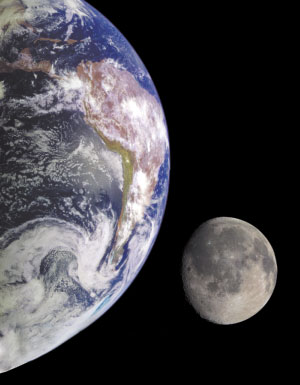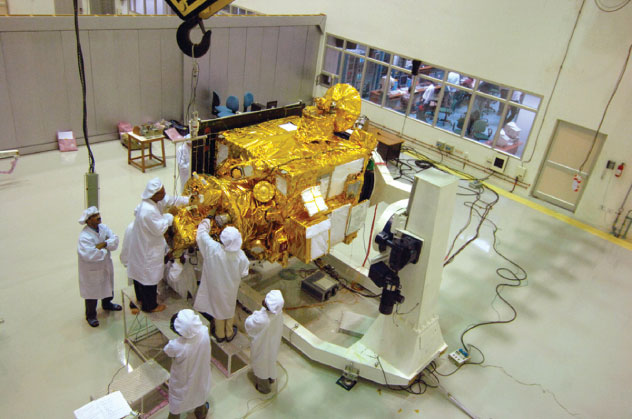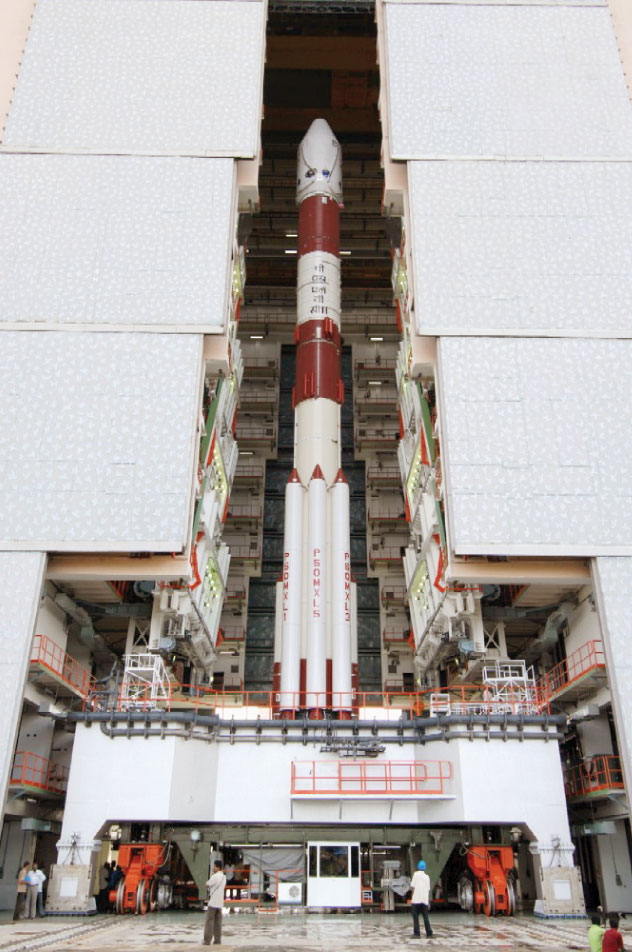COVER STORY
Over the Moon: The Launch of Chandrayaan-1
In the midst of a global financial meltdown and a stock market crash, the historic launch of India’s first unmanned spacecraft bound for the Moon has brought some cheer, writes Priyanka Bhardwaj.

(Above): PSLV-C11 liftoff. [ISRO photo]
 Chandrayaan-1 (the word means Moon-vehicle in Sanskrit) has left for the Moon. Chandrayaan-1 (the word means Moon-vehicle in Sanskrit) has left for the Moon.
In the midst of a global financial meltdown and a stock market crash, there has been some cheer as India has demonstrated its prowess in joining the elite nuclear and now space club.
India successfully put its first unmanned spacecraft, Chandrayaan-1, using an indigenously manufactured Polar Satellite Launch Vehicle, into its initial orbit, at 6:22 a.m. Oct. 22, from the Satish Dhawan Space Centre in Sriharikota on the eastern coast.
India thus completes the Asian triangle in the space race among Asian economic powerhouses, as Chandrayaan-1 follows China’s Chang’e and Japan’s Kaguya missions.
Indian observers see a continued space engagement as crucial from civilian, military, economic and strategic senses. India also wants to be prepared should the global arms race extends further into space, due to inter-related dual use technologies.
The government-run Indian Space Research Organization has worked against tough odds to achieve this historical moment and the beginning of a new era.
The Moon craft is scheduled to reach its final destination in three weeks.
Weighing about 1,380 kg (3,042 lbs), the cube-shaped spacecraft, on a two-year mission, will be “looking for basic signatures of the evolution of the earth and Moon, the exploration of the terrain for its three-dimensional topography and the different quantities of minerals present there,” said G. Madhavan Nair, chairman of ISRO.
This unique topographical and chemical analysis never undertaken on such a scale before.
India joins the ranks of the former Soviet Union, the United States, the European Space Agency, and Japan who have to their credit 60 individual lunar missions and China, whose third manned space mission went off without a hitch in September. The Shenzhou-7 is now safely in orbit..
The spacecraft will drop the Indian flag on the surface of the Moon. The country’s tricolor is painted on the side of the probe and, if successful, India will become the fourth country after the U.S., Russia and Japan to place its national flag on the lunar surface.
India now has plans for a robotic mission next year and a manned lunar mission by 2012-2013. Preparations for an Indian mission to the Mars are in full swing.
Roddam Narasimaiah, a member of the Bangalore-based Indian Space Commission said, “The success of the Moon mission will lead to a second wave of adventure in space in line with the vision of the founding fathers of the Indian space program like Vikram Sarabhai and Satish Dhawan.’’
In the words of K. Kasturirangan, former head of the ISRO, the Moon mission will further strengthen India’s resolve to fight her problems of hunger, poverty, energy and illiteracy.

(Above): Chandrayaan-I spacecraft undergoing pre-launch tests. [ISRO photo]
International Acclaim
David Southwood, director of science and robotic exploration at the European Space Agency congratulated India’s space agency on the launch.
“While the exploration of space calls for new challenges to be overcome, joining forces is becoming more and more a key to future successes,” he said.
Barry Kellett, project scientist on the C1XS instrument, which was built at the Rutherford-Appleton Laboratory in the U.K., said: “Chandrayaan-1 has a very competitive set of instruments... it will certainly do good science.”
C1XS will map the abundance of different elements in the lunar crust to help answer key questions about the origin and evolution of Earth’s only natural satellite.
Chandrayaan-1 Specifications
- Cuboid in shape of approximately 1.5 m side.
- Weight 1380 kg at launch and 675 kg at lunar orbit.
- Accommodates eleven science payloads.
- 3-axis stabilized spacecraft using two star sensors, gyros and four reaction wheels
- Deployable single panel solar array generates 750W power.
- During eclipse, spacecraft will be powered by Lithium ion batteries.
- X-band, 0.7m diameter parabolic antenna for payload data transmission.
- The antenna employs a dual gimbal mechanism to track the earth station when the spacecraft is in lunar orbit.
- Propulsion system carries required propellant for a mission life of 2 years, with adequate margin.
- The Telemetry, Tracking & Command communication is in S-band frequency.
- Scientific payload data transmission is in X-band frequency
- Spacecraft has three Solid State Recorders Onboard to record data from various payloads.
|
U.S Fears
U.S. scientists have been watching the Moon missions by Asian economic giants with some trepidation as the scramble for a place in the Moon heats up.
U.S. astrophysicists, space engineers and scientists have warned that its superpower status may be lost if it ignored the Asian space race.
The U.S. government has announced its intention of revisiting its lunar program and sending a manned mission to Mars in the coming decades.
It has noted with caution that in the interest of its economic and strategic security, it needs to address a growing deficit in funds and enthusiasm as the Asian emerging nations power ahead with their space programs.
According to a report from the U.S. National Academy of Science, the number of Chinese and Indian scientists graduating in 2004 is 200,000 and 50,000 respectively, compared to the 70,000 in the U.S.

(Above): PSLV-C11 coming out of the Vehicle Assembly Building. [ISRO photo]
Space Business
At an estimated cost of $80 million, Chandrayaan-1 is a brave marketing accomplishment that heralds promising business opportunities for India.
It consolidates India’s brand power in terms of its capability of carrying out complex projects with cost effective and quality launches. It furthers India’s credentials in space technology, indigenous development of powerful launch vehicles.
The Chandrayaan-1 cost was 10 percent of the annual ISRO budget. Out of nearly Rs 4 billion, Rs 1 billion was for the Deep Space Network, over Rs. 1 billion for the satellite and the rest for the launch vehicle.
V.M. Trehan, chairman of the Indian Science Congress, described Chandrayaan-1 as a huge economic and strategic achievement for India.
The launch vehicle business of heavier payloads is a commercially attractive option as the GSLV and PSLV services of India costs 70-80 percent of international rates.
The commercial arm of ISRO, Antrix Corporation, could fetch business for its 32m dish antenna installed at Bangalore and from the GSLV and PSLV launches.
Indian manufactured satellites already have buyers from Germany, Indonesia, Belgium and Argentina since 2001.
The business of payloads has attracted nations like Britain, the U.S., Germany, Sweden, Bulgaria and the data vending mileage that Antrix hopes to achieve is also substantial.
Vikram Sarabhai Space Centre projects director S. Ramakrishnan estimates that the PSLV can take a 250 kg spacecraft to the Mars and the GSLV-mark III can put a 1 metric ton spacecraft in orbit around the Mars.
Recent Missions to the Moon
- CHANDRAYAAN-1 — was launched from Sriharikota in India Oct. 22, 2008.
- CHANG’E 1 — was launched from Xichang in China on Oct. 24, 2007.
- KAGUYA — was launched from Tanegashima in Japan on Sept. 14, 2007.
- SMART 1 — was launched from Kourou in French Guiana on Sept. 27, 2003.
- LUNAR PROSPECTOR — was launched from the Kennedy Space Centre Jan. 7, 1998.
- ASIASAT 3/HGS-1 — A project funded by Asia Satellite Telecommunications (Peoples Republic of China) and Pan American Satellite (United States), it was launched from Tyuratam in Kazakhstan Dec. 24, 1997.
- CLEMENTINE — A joint project between the Strategic Defense Initiative Organisation and NASA, it was launched from Vandenberg AFB aboard a Titan IIG rocket Jan. 25, 1994.
- HITEN — A project of the Japanese Space Agency, it was launched from the Uchinaoura Space Center in Japan on January 24, 1990.
|
Technical Breakthroughs
The Indian Moon saga has demonstrated a high-level cooperation in space technology, as 6 out of the 11 scientific instruments were contributed by the foreign nations; two from NASA and three from the European Space Agency and one from Bulgaria.
It proves that space faring countries have confidence in India’s ability to venture into space explorations.
The spectrum of coverage of the 11 instruments on board the Moon spacecraft is also remarkable.
The Lunar Laser Ranging instrument would send high energy lasers to the Moon’s surface that are bounced back to reveal the depth of craters and height of mountains even in permanently shadowed regions never explored before.
The task of digital mapping of the Moon may act as a springboard to explore other planets and lay out a clear roadmap for future lunar exploration, says Jitendra Goswami, chief scientist of the Indian Moon program.
The Moon impact probe with a mass spectrometer, a video camera and an altimeter will analyze atmospheric constituents, take pictures and also facilitate with data for India’s future manned Moon mission to land on the lunar surface with accuracy.
Experts believe that the IT industry, civilian nuclear program, military applications will receive a boost.
The presence of Helium 3 in the Moon’s crust and its probable exploitation may furnish nuclear fuel that could provide a critical energy breakthrough.
|